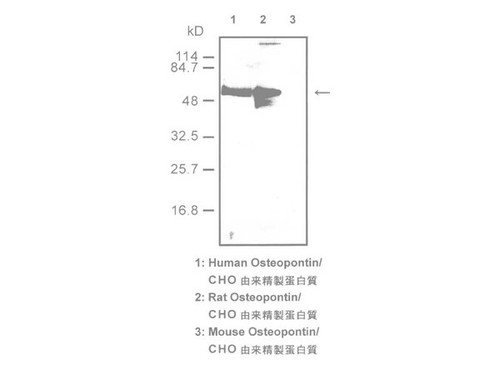Osteopontin (OPN) is a secreted glycoprotein that was originally isolated from bone. Its molecular weights have been reported in the range of 66 kDa to 44 kDa depending on glycosylation and phosphorylation. OPN is also known to be expressed in other fluids and tissues including milk, urine, activated T cells, smooth muscle cells, kidney and some tumor cells. OPN contains an Arg-Gly-Asp (RGD) amino acid sequence. This motif is present in fibronectin, vitronectin and a variety of other extra-cellular proteins that bind members of the integrin family of cell surface receptors such as αvβ3. OPN was also identified as a ligand for CD44, which levels correlate with aggressiveness of lymphoid tumors and invasiveness of bladder carcinoma. Its interaction does not require RGD motif of OPN. In OPN knockout mice, it has been reported that a significantly decreased level of debridement was shown. Although the distribution and expression pattern of OPN in the human body have suggested the multiple function of OPN, its function under different situations remain obscure. And it is reported the N-terminal OPN fragment cleaved by thrombin (OPN N-Half) binds to α4 or α9 integrin, and the relation with many inflammatory disease is suggested. For research use only, not for use in diagnostic procedures.
- application:
- WB
- Catalog number:
- 11108-S
- clone:
- 34E3
- concentration:
- Please see datasheet
- Datasheet:
- formulation:
- Lyophilized product from 1% BSA in PBS containing 0.05% NaN3
- immunogen:
- Synthetic peptide for a part of Human Osteopontin (SVVYGLR)
- isotype:
- IgG1
- MSDS:
- notes:
- For research use only, not for use in diagnostic procedures.
The datasheet for this product (see above) is intended to serve as an example only. Please refer to the datasheet provided with the antibody for precise details. - Other names:
- Please see datasheet
- Protocol:
- size:
- 10 µg
- storage:
- Lyophilized product, 5 years at 2 - 8 °C; Solution, 2 years at -20 °C
- Species:
- Human
- Host:
- Mouse
- Additional info:
- References:







